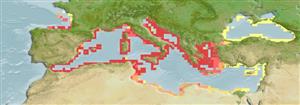Common names from other countries
>
Eupercaria/misc (Various families in series Eupercaria) >
Labridae (Wrasses)
Etymology: Symphodus: Greek, syn, symphysis = grown together + Greek, odous = teeth (Ref. 45335).
More on author: Linnaeus.
Issue
See nomenclatural details in Eschmeyer (CofF ver. Oct. 2012: Ref. 92135).
Environment: milieu / climate zone / depth range / distribution range
Ecologia
marino associati a barriera corallina; distribuzione batimetrica 1 - 30 m. Subtropical; 47°N - 30°N, 6°W - 42°E
Eastern Atlantic: throughout the Mediterranean, Black Sea and Sea of Azov.
Length at first maturity / Size / Peso / Age
Maturity: Lm 4.0 range ? - ? cm
Max length : 18.5 cm TL maschio/sesso non determinato; (Ref. 122896); peso massimo pubblicato: 81.69 g (Ref. 122896); Età massima riportata: 5 anni (Ref. 4742)
Adults are found near rocks and eel-grass beds. A nest of seaweed (Cystoseria) built and kept by male. Feed on bryozoans, hydroids, tubicolous, worms, shrimps, amphipods and mollusks. Males grow faster than females (Ref. 4742). Undergoes sex reversal (Ref. 4742). Oviparous, distinct pairing during breeding (Ref. 205).
Undergoes sex reversal (Ref. 4742). Oviparous, distinct pairing during breeding (Ref. 205). Males build dish shaped nests and guard the eggs (Ref. 205).
Quignard, J.-P. and A. Pras, 1986. Labridae. p. 919-942. In P.J.P. Whitehead, M.-L. Bauchot, J.-C. Hureau, J. Nielsen and E. Tortonese (eds.) Fishes of the north-eastern Atlantic and the Mediterranean. UNESCO, Paris. Vol. 2. (Ref. 4742)
IUCN Red List Status (Ref. 130435)
CITES (Ref. 128078)
Not Evaluated
Threat to humans
Harmless
Human uses
Pesca: commerciale; Acquario: Commerciale
Strumenti
Special reports
Download XML
Fonti Internet
Estimates based on models
Preferred temperature (Ref.
115969): 16.5 - 21.1, mean 18.9 (based on 421 cells).
Phylogenetic diversity index (Ref.
82804): PD
50 = 0.5005 [Uniqueness, from 0.5 = low to 2.0 = high].
Bayesian length-weight: a=0.01202 (0.00993 - 0.01456), b=3.09 (3.05 - 3.13), in cm Total Length, based on LWR estimates for this species (Ref.
93245).
Trophic level (Ref.
69278): 3.5 ±0.0 se; based on diet studies.
Resilienza (Ref.
120179): Medio, tempo minimo di raddoppiamento della popolazione 1.4 - 4.4 anni (K=0.64-0.95; tm=1-2; tmax=5).
Fishing Vulnerability (Ref.
59153): Low vulnerability (22 of 100).
